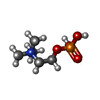[English] 日本語
 Yorodumi
Yorodumi- PDB-6c74: Crystal Structure of Murine CD300lf in complex with phosphocholine -
+ Open data
Open data
- Basic information
Basic information
| Entry | Database: PDB / ID: 6c74 | |||||||||
|---|---|---|---|---|---|---|---|---|---|---|
| Title | Crystal Structure of Murine CD300lf in complex with phosphocholine | |||||||||
 Components Components | CMRF35-like molecule-1 | |||||||||
 Keywords Keywords | LIPID BINDING PROTEIN / CD300lf / IgV-like domain / myeloid receptor / CMRF-35-like molecule-1 / CLM-1 / CLM1 / DIR2 / IREM1 / LMIR3 / PIGR3. IgSF13 | |||||||||
| Function / homology |  Function and homology information Function and homology informationnegative regulation of MyD88-dependent toll-like receptor signaling pathway / interleukin-13-mediated signaling pathway / negative regulation of mast cell activation / interleukin-4 receptor binding / negative regulation of apoptotic cell clearance / positive regulation of interleukin-4-mediated signaling pathway / ceramide binding / positive regulation of apoptotic cell clearance / TRIF-dependent toll-like receptor signaling pathway / phosphatidylserine binding ...negative regulation of MyD88-dependent toll-like receptor signaling pathway / interleukin-13-mediated signaling pathway / negative regulation of mast cell activation / interleukin-4 receptor binding / negative regulation of apoptotic cell clearance / positive regulation of interleukin-4-mediated signaling pathway / ceramide binding / positive regulation of apoptotic cell clearance / TRIF-dependent toll-like receptor signaling pathway / phosphatidylserine binding / osteoclast differentiation / virus receptor activity / plasma membrane Similarity search - Function | |||||||||
| Biological species |  | |||||||||
| Method |  X-RAY DIFFRACTION / X-RAY DIFFRACTION /  SYNCHROTRON / SYNCHROTRON /  MOLECULAR REPLACEMENT / MOLECULAR REPLACEMENT /  molecular replacement / Resolution: 1.358 Å molecular replacement / Resolution: 1.358 Å | |||||||||
 Authors Authors | Nelson, C.A. / Fremont, D.H. | |||||||||
| Funding support |  United States, 2items United States, 2items
| |||||||||
 Citation Citation |  Journal: Proc Natl Acad Sci U S A / Year: 2018 Journal: Proc Natl Acad Sci U S A / Year: 2018Title: Structural basis for murine norovirus engagement of bile acids and the CD300lf receptor. Authors: Christopher A Nelson / Craig B Wilen / Ya-Nan Dai / Robert C Orchard / Arthur S Kim / Roderick A Stegeman / Leon L Hsieh / Thomas J Smith / Herbert W Virgin / Daved H Fremont /  Abstract: Murine norovirus (MNoV) is closely related to human norovirus (HNoV), an infectious agent responsible for acute gastroenteritis worldwide. Here we report the X-ray crystal structure of the dimeric ...Murine norovirus (MNoV) is closely related to human norovirus (HNoV), an infectious agent responsible for acute gastroenteritis worldwide. Here we report the X-ray crystal structure of the dimeric MNoV VP1 protruding (P) domain in complex with its cellular receptor CD300lf. CD300lf binds the P domain with a 2:2 stoichiometry, engaging a cleft between the AB and DE loops of the P2 subdomain at a site that overlaps the epitopes of neutralizing antibodies. We also identify that bile acids are cofactors enhancing MNoV cell-binding and infectivity. Structures of CD300lf-P domain in complex with glycochenodeoxycholic acid (GCDCA) and lithocholic acid (LCA) reveal two bile acid binding sites at the P domain dimer interface distant from receptor binding sites. The structural determinants for receptor and bile acid binding are supported by numerous biophysical assays utilizing interface residue mutations. We find that the monomeric affinity of CD300lf for the P domain is low and is divalent cation dependent. We have also determined the crystal structure of CD300lf in complex with phosphocholine, revealing that MNoV engages its receptor in a manner mimicking host ligands including similar metal coordination. Docking of the cocomplex structures onto a cryo-EM-derived model of MNoV suggests that each virion can make multiple CD300lf engagements, and thus, infection may be driven by the avidity of cell surface clustered CD300lf. These studies identify multiple potential modulators of norovirus infection that may act to regulate the interaction between the viral capsid P domain and its cognate cellular receptor. | |||||||||
| History |
|
- Structure visualization
Structure visualization
| Structure viewer | Molecule:  Molmil Molmil Jmol/JSmol Jmol/JSmol |
|---|
- Downloads & links
Downloads & links
- Download
Download
| PDBx/mmCIF format |  6c74.cif.gz 6c74.cif.gz | 60.5 KB | Display |  PDBx/mmCIF format PDBx/mmCIF format |
|---|---|---|---|---|
| PDB format |  pdb6c74.ent.gz pdb6c74.ent.gz | 42.6 KB | Display |  PDB format PDB format |
| PDBx/mmJSON format |  6c74.json.gz 6c74.json.gz | Tree view |  PDBx/mmJSON format PDBx/mmJSON format | |
| Others |  Other downloads Other downloads |
-Validation report
| Summary document |  6c74_validation.pdf.gz 6c74_validation.pdf.gz | 431 KB | Display |  wwPDB validaton report wwPDB validaton report |
|---|---|---|---|---|
| Full document |  6c74_full_validation.pdf.gz 6c74_full_validation.pdf.gz | 431 KB | Display | |
| Data in XML |  6c74_validation.xml.gz 6c74_validation.xml.gz | 8.2 KB | Display | |
| Data in CIF |  6c74_validation.cif.gz 6c74_validation.cif.gz | 11.2 KB | Display | |
| Arichive directory |  https://data.pdbj.org/pub/pdb/validation_reports/c7/6c74 https://data.pdbj.org/pub/pdb/validation_reports/c7/6c74 ftp://data.pdbj.org/pub/pdb/validation_reports/c7/6c74 ftp://data.pdbj.org/pub/pdb/validation_reports/c7/6c74 | HTTPS FTP |
-Related structure data
| Related structure data |  7564C 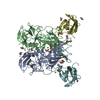 6c6qC 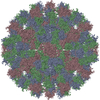 6crjC 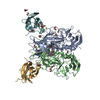 6e47C 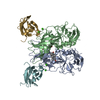 6e48C  5fflS S: Starting model for refinement C: citing same article ( |
|---|---|
| Similar structure data |
- Links
Links
- Assembly
Assembly
| Deposited unit | 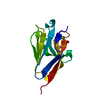
| ||||||||
|---|---|---|---|---|---|---|---|---|---|
| 1 |
| ||||||||
| Unit cell |
|
- Components
Components
| #1: Protein | Mass: 12554.189 Da / Num. of mol.: 1 / Fragment: ectodomain (UNP residues 20-130) Source method: isolated from a genetically manipulated source Source: (gene. exp.)   |
|---|---|
| #2: Chemical | ChemComp-PC / |
| #3: Chemical | ChemComp-CA / |
| #4: Water | ChemComp-HOH / |
| Has protein modification | Y |
-Experimental details
-Experiment
| Experiment | Method:  X-RAY DIFFRACTION / Number of used crystals: 1 X-RAY DIFFRACTION / Number of used crystals: 1 |
|---|
- Sample preparation
Sample preparation
| Crystal | Density Matthews: 1.78 Å3/Da / Density % sol: 30.82 % |
|---|---|
| Crystal grow | Temperature: 293 K / Method: vapor diffusion, hanging drop / pH: 8.7 / Details: 0.1 M Phosphocholine, pH 7.4, 33% PEG3350 |
-Data collection
| Diffraction | Mean temperature: 100 K | ||||||||||||||||||||||||
|---|---|---|---|---|---|---|---|---|---|---|---|---|---|---|---|---|---|---|---|---|---|---|---|---|---|
| Diffraction source | Source:  SYNCHROTRON / Site: SYNCHROTRON / Site:  ALS ALS  / Beamline: 4.2.2 / Wavelength: 1.00004 Å / Beamline: 4.2.2 / Wavelength: 1.00004 Å | ||||||||||||||||||||||||
| Detector | Type: NOIR-1 / Detector: CMOS / Date: Oct 29, 2017 | ||||||||||||||||||||||||
| Radiation | Monochromator: double crystal Si(111) / Protocol: SINGLE WAVELENGTH / Monochromatic (M) / Laue (L): M / Scattering type: x-ray | ||||||||||||||||||||||||
| Radiation wavelength | Wavelength: 1.00004 Å / Relative weight: 1 | ||||||||||||||||||||||||
| Reflection | Resolution: 1.35→40.02 Å / Num. obs: 35969 / % possible obs: 98.4 % / Redundancy: 11.8 % / CC1/2: 0.998 / Rmerge(I) obs: 0.132 / Rpim(I) all: 0.039 / Rrim(I) all: 0.138 / Net I/σ(I): 10.6 | ||||||||||||||||||||||||
| Reflection shell | Diffraction-ID: 1
|
-Phasing
| Phasing | Method:  molecular replacement molecular replacement |
|---|
- Processing
Processing
| Software |
| |||||||||||||||||||||||||||||||||||||||||||||||||||||||||||||||||||||||||||||||||||||||||||||||||||||||||||||||||||||||||||||||||||||||||||||||||||||||||||||||||||||||||||||||||||||||||||||
|---|---|---|---|---|---|---|---|---|---|---|---|---|---|---|---|---|---|---|---|---|---|---|---|---|---|---|---|---|---|---|---|---|---|---|---|---|---|---|---|---|---|---|---|---|---|---|---|---|---|---|---|---|---|---|---|---|---|---|---|---|---|---|---|---|---|---|---|---|---|---|---|---|---|---|---|---|---|---|---|---|---|---|---|---|---|---|---|---|---|---|---|---|---|---|---|---|---|---|---|---|---|---|---|---|---|---|---|---|---|---|---|---|---|---|---|---|---|---|---|---|---|---|---|---|---|---|---|---|---|---|---|---|---|---|---|---|---|---|---|---|---|---|---|---|---|---|---|---|---|---|---|---|---|---|---|---|---|---|---|---|---|---|---|---|---|---|---|---|---|---|---|---|---|---|---|---|---|---|---|---|---|---|---|---|---|---|---|---|---|---|
| Refinement | Method to determine structure:  MOLECULAR REPLACEMENT MOLECULAR REPLACEMENTStarting model: PDB entry 5FFL Resolution: 1.358→34.552 Å / SU ML: 0.16 / Cross valid method: THROUGHOUT / σ(F): 1.34 / Phase error: 19.36
| |||||||||||||||||||||||||||||||||||||||||||||||||||||||||||||||||||||||||||||||||||||||||||||||||||||||||||||||||||||||||||||||||||||||||||||||||||||||||||||||||||||||||||||||||||||||||||||
| Solvent computation | Shrinkage radii: 0.9 Å / VDW probe radii: 1.11 Å | |||||||||||||||||||||||||||||||||||||||||||||||||||||||||||||||||||||||||||||||||||||||||||||||||||||||||||||||||||||||||||||||||||||||||||||||||||||||||||||||||||||||||||||||||||||||||||||
| Displacement parameters | Biso max: 68.13 Å2 / Biso mean: 17.7317 Å2 / Biso min: 7.12 Å2 | |||||||||||||||||||||||||||||||||||||||||||||||||||||||||||||||||||||||||||||||||||||||||||||||||||||||||||||||||||||||||||||||||||||||||||||||||||||||||||||||||||||||||||||||||||||||||||||
| Refinement step | Cycle: final / Resolution: 1.358→34.552 Å
| |||||||||||||||||||||||||||||||||||||||||||||||||||||||||||||||||||||||||||||||||||||||||||||||||||||||||||||||||||||||||||||||||||||||||||||||||||||||||||||||||||||||||||||||||||||||||||||
| Refine LS restraints |
| |||||||||||||||||||||||||||||||||||||||||||||||||||||||||||||||||||||||||||||||||||||||||||||||||||||||||||||||||||||||||||||||||||||||||||||||||||||||||||||||||||||||||||||||||||||||||||||
| LS refinement shell | Refine-ID: X-RAY DIFFRACTION / Rfactor Rfree error: 0 / Total num. of bins used: 26
|
 Movie
Movie Controller
Controller


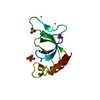

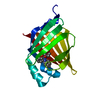



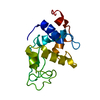
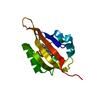
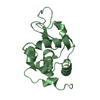
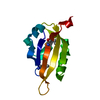
 PDBj
PDBj